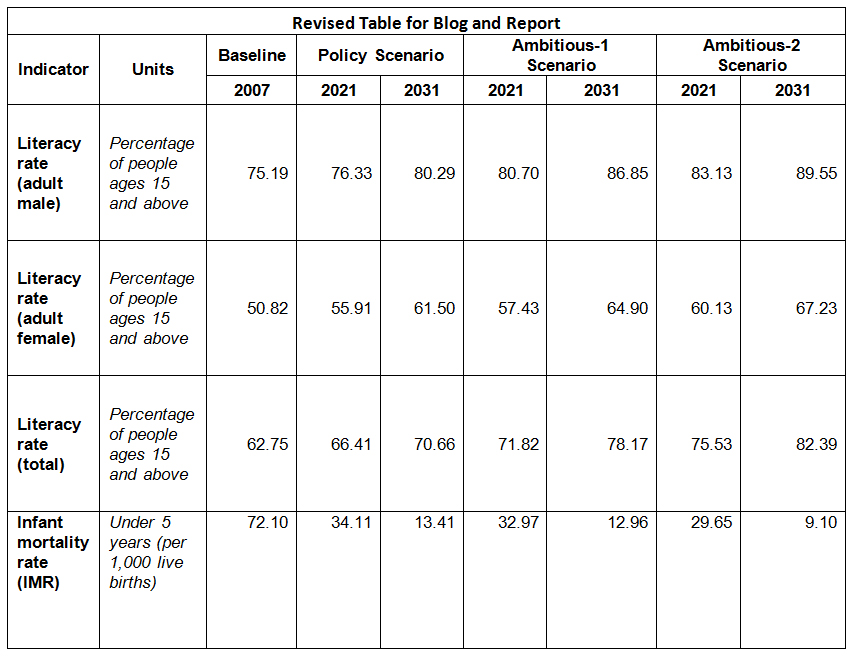Can green growth interventions contribute to India's national policy vision?
India's national policy vision on green growth
The Ministry of Environment, Forests and Climate Change, Government of India recognizes 'poverty eradication along with green growth' as central to India's sustainable development vision. This vision also embodies the cogent definition of green growth by the Thirteenth Finance Commission of India as a narrative that enables rethinking growth strategies with regard to their impact(s) on environmental sustainability and inclusiveness. Poverty eradication and socio-economic inclusion assumes a pivotal role in operationalizing the construct of green growth in India's policy planning and implementation process. The clear emphasis here has been on a growth strategy that generates development and welfare dividends not affecting while achieving economic returns.
Knowledge initiative on green growth
A collaborative knowledge initiative implemented by The Energy and Resources Institute (TERI) and the Global Green Growth Institute (GGGI)-Initiative on Green Growth and Development in India - evaluates options by which the Indian economy can move towards an inclusive green growth paradigm of development.
In order to understand linkages between green energy interventions at the national level and their development outcomes, an integrated assessment was carried out using a suite of economic models - TERI-MARKAL (MARKet ALlocation) for energy systems analysis, and a simulation based dynamic, recursive computable general equilibrium (CGE) model for macro-economic analysis. In addition, detailed policy assessment was carried out for seventeen priority green growth sectors/sub-sectors, including coal, oil & gas, renewable energy, industry, agriculture, buildings, transport, forests, biodiversity, air pollution, water, waste management and climate change adaptation. A national workshop was organized to present the key findings of the project and facilitate discussion by bringing together various stakeholders - policymakers, technical experts, development practitioners, and civil society.
Findings
The national integrated exercise shows that green growth interventions alone can bring about significant positive change by lifting people above poverty, and thereby impacting the key education and health indicators as well. These green growth interventions include increased share of renewables in the energy mix, sustainable agriculture practices, better natural resource management, and structural changes within industry and infrastructure sector. As income is generated by way of increased economic activities, new investments get distributed in households-especially across the rural households- thereby reducing the inequality.
Our assessment suggests that additional skilled and unskilled jobs would also be created. An additional employment of almost 12 Million is envisaged due to energy and energy related infrastructure interventions over a time-horizon of 2031 in the most ambitious scenario. Within the modelling exercise, reference scenario matches close to the world of business as usual, policy scenario is the one in which policy declarations are achieved and ambitious scenario depicts a world where interventions beyond the declared policy goals can become achievable. A complementary increase in both the skilled and unskilled job creation in the ambitious scenarios also leads to incremental income generation, reduction in poverty and substantial developmental benefits related to education and health. The table below gives an overview of developmental benefits in terms of literacy and infant mortality.

Discussion
The modelling results clearly suggests that green growth interventions can contribute to India's green growth vision of poverty eradication and inclusive growth. However, the crucial question that remains is around the implementation of these interventions, especially the scale of financing needed. Under the most ambitious scenario, 14.52% of the GDP at factor cost by 2031 would be required to be invested in various green growth interventions across sectors. Mobilizing finance, both domestic and international, along with enhancing financial, technical and institutional capacities of government as well as the voluntary sector will be two key drivers of implementation.
The research highlights crucial data gaps, especially related to environmental indicators, which are critical to facilitate nuanced decision-making as well as evaluation of existing policy initiatives. Currently data on waste management, air quality and water are still inadequate for robust decision-making.
Climate-resilient green growth strategies also need to be looked at as a cross-cutting issue that requires policy coherence and inter-departmental coordination for planning and implementation. The chair of the project steering committee, Shri B K Chaturvedi, highlighted the need for a 'powerful implementer' given that green growth and sustainable development is cross-cutting approaches by nature. Strong institutions and coordination mechanisms that can exercise power and influence in policy designing, implementation and monitoring across multiple sectors, both at the centre and state level need to be institutionalized. Earmarking qualifying allocations and expenditure items in state budgets for interventions in key sectors, as green budgets, could be the first step towards realizing the green growth paradigm by achieving development and welfare dividends.
Ways forward
Our analyses and stakeholder engagements prove that GGS are highly effective and important policy tools and development strategies that yield welfare dividends while furthering India's ability to meet international development (SDGs) and climate commitments (UNFCCC) while achieving sustainable, economic growth aspirations of the country.
The study provides a review of long-term sustainability challenges in India and concludes that green growth strategies yields multiple development benefits, but their implementation requires concerted policy action. By quantifying developmental outcomes of green growth interventions, this analysis intends to open a discussion among stakeholders in the policy and development space. Also, it becomes clear that objective inquiry and stakeholder engagement will be crucial to nudge the development community to reflect on inconvenient questions of resource scarcity, security and the limitations of current economic systems.
